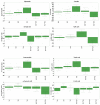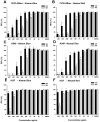Enhanced Recovery of Antioxidant Compounds from Hazelnut (Corylus avellana L.) Involucre Based on Extraction Optimization: Phytochemical Profile and Biological Activities
- PMID: 31597384
- PMCID: PMC6826866
- DOI: 10.3390/antiox8100460
Enhanced Recovery of Antioxidant Compounds from Hazelnut (Corylus avellana L.) Involucre Based on Extraction Optimization: Phytochemical Profile and Biological Activities
Abstract
Tree nut by-products could contain a wide range of phytochemicals, natural antioxidants, which might be used as a natural source for dietary supplements. The aim of the present study was to evaluate the phenolic and sterolic composition, as well as the antioxidant and other biological activities, of hazelnut involucre (HI) extracts. Experimental designs were developed in order to select the optimum extraction conditions (solvent, temperature, time) using turbo-extraction by Ultra-Turrax for obtaining extracts rich in bioactive compounds. Qualitative and quantitative analyses were performed by LC-MS and LC-MS/MS and they revealed important amounts of individual polyphenols and phytosterols, molecules with antioxidant potential. The richest polyphenolic HI extract with the highest antioxidant activity by TEAC assay was further evaluated by other in vitro antioxidant tests (DPPH, FRAP) and enzyme inhibitory assays. Additionally, the cytotoxic and antioxidant effects of this extract on two cancerous cell lines and on normal cells were tested. This is the first study to analyze the composition of both hydrophilic and lipophilic bioactive compounds in HI extracts. Our findings reveal that this plant by-product presents strong biological activities, justifying further research, and it could be considered an inexpensive source of natural antioxidants for food, pharmaceutical, or cosmetic industry.
Keywords: LC-MS; Ultra-Turrax; antioxidants; biological activity; enzymatic inhibition; experimental design; hazelnut involucre; phytosterols; polyphenols; turbo-extraction.
Conflict of interest statement
The authors declare no conflict of interest.
Figures







Similar articles
-
Process Optimization for Improved Phenolic Compounds Recovery from Walnut (Juglans regia L.) Septum: Phytochemical Profile and Biological Activities.Molecules. 2018 Oct 30;23(11):2814. doi: 10.3390/molecules23112814. Molecules. 2018. PMID: 30380713 Free PMC article.
-
Enhanced Recovery of Phenolic and Tocopherolic Compounds from Walnut (Juglans Regia L.) Male Flowers Based on Process Optimization of Ultrasonic Assisted-Extraction: Phytochemical Profile and Biological Activities.Antioxidants (Basel). 2021 Apr 15;10(4):607. doi: 10.3390/antiox10040607. Antioxidants (Basel). 2021. PMID: 33920912 Free PMC article.
-
LC-MS profiling highlights hazelnut (Nocciola di Giffoni PGI) shells as a byproduct rich in antioxidant phenolics.Food Res Int. 2017 Nov;101:180-187. doi: 10.1016/j.foodres.2017.08.063. Epub 2017 Sep 1. Food Res Int. 2017. PMID: 28941682
-
Hazelnut and its by-products: A comprehensive review of nutrition, phytochemical profile, extraction, bioactivities and applications.Food Chem. 2023 Jul 1;413:135576. doi: 10.1016/j.foodchem.2023.135576. Epub 2023 Jan 25. Food Chem. 2023. PMID: 36745946 Review.
-
Final report on the safety assessment of Corylus Avellana (Hazel) Seed Oil, Corylus Americana (Hazel) Seed Oil, Corylus Avellana (Hazel) Seed Extract, Corylus Americana (Hazel) Seed Extract, Corylus Avellana (Hazel) Leaf Extract, Corylus Americana (Hazel) Leaf Extract, and Corylus Rostrata (Hazel) Leaf Extract.Int J Toxicol. 2001;20 Suppl 1:15-20. doi: 10.1080/109158101750300928. Int J Toxicol. 2001. PMID: 11358108 Review.
Cited by
-
Antioxidant Effects of Walnut (Juglans regia L.) Kernel and Walnut Septum Extract in a D-Galactose-Induced Aging Model and in Naturally Aged Rats.Antioxidants (Basel). 2020 May 14;9(5):424. doi: 10.3390/antiox9050424. Antioxidants (Basel). 2020. PMID: 32423149 Free PMC article.
-
UPLC-MS/MS profiling, antioxidant and anti-inflammatory activities, and potential health benefits prediction of phenolic compounds in hazel leaf.Front Nutr. 2023 Feb 1;10:1092071. doi: 10.3389/fnut.2023.1092071. eCollection 2023. Front Nutr. 2023. PMID: 36819681 Free PMC article.
-
Antitussive, Antioxidant, and Anti-Inflammatory Effects of a Walnut (Juglans regia L.) Septum Extract Rich in Bioactive Compounds.Antioxidants (Basel). 2021 Jan 15;10(1):119. doi: 10.3390/antiox10010119. Antioxidants (Basel). 2021. PMID: 33467612 Free PMC article.
-
Optimized Sambucus nigra L., Epilobium hirsutum L., and Lythrum salicaria L. Extracts: Biological Effects Supporting Their Potential in Wound Care.Antioxidants (Basel). 2025 Apr 27;14(5):521. doi: 10.3390/antiox14050521. Antioxidants (Basel). 2025. PMID: 40427403 Free PMC article.
-
Phytochemical Profile and Biological Activities of Tendrils and Leaves Extracts from a Variety of Vitis vinifera L.Antioxidants (Basel). 2020 Apr 30;9(5):373. doi: 10.3390/antiox9050373. Antioxidants (Basel). 2020. PMID: 32365793 Free PMC article.
References
-
- Arias-Fernández L., Machado-Fragua M., Graciani A., Guallar-Castillón P., Banegas J., Rodríguez-Artalejo F., Lana A., Lopez-Garcia E. Prospective Association Between Nut Consumption and Physical Function in Older Men and Women. J. Gerontol. A Biol. Sci. Med. Sci. 2018;74:1091–1097. - PubMed
-
- Rusu M.E., Simedrea R., Gheldiu A.-M., Mocan A., Vlase L., Popa D.-S., Ferreira I.C.F.R. Benefits of tree nut consumption on aging and age-related diseases: Mechanisms of actions. Trends Food Sci. Technol. 2019;88:104–120. doi: 10.1016/j.tifs.2019.03.006. - DOI
LinkOut - more resources
Full Text Sources
Miscellaneous

